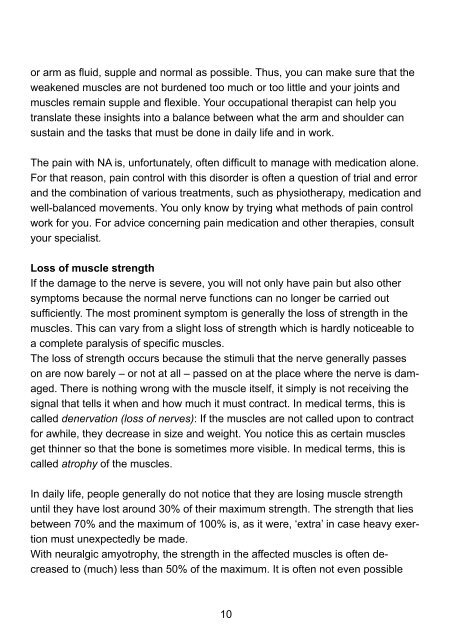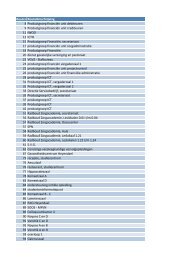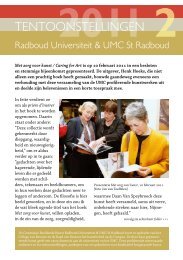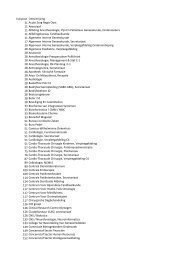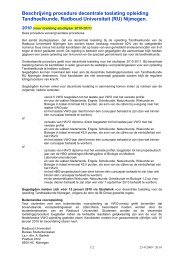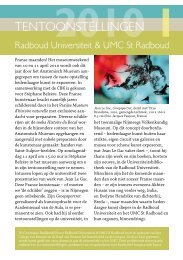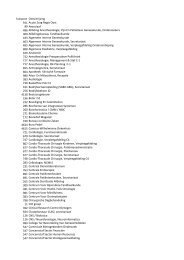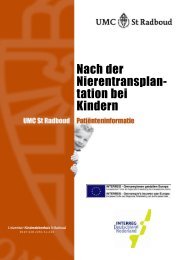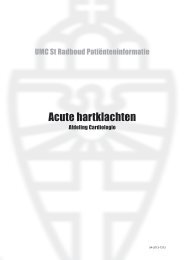Neuralgic Amyotrophy: idiopathic and hereditary ... - UMC St Radboud
Neuralgic Amyotrophy: idiopathic and hereditary ... - UMC St Radboud
Neuralgic Amyotrophy: idiopathic and hereditary ... - UMC St Radboud
Create successful ePaper yourself
Turn your PDF publications into a flip-book with our unique Google optimized e-Paper software.
or arm as fluid, supple <strong>and</strong> normal as possible. Thus, you can make sure that the<br />
weakened muscles are not burdened too much or too little <strong>and</strong> your joints <strong>and</strong><br />
muscles remain supple <strong>and</strong> flexible. Your occupational therapist can help you<br />
translate these insights into a balance between what the arm <strong>and</strong> shoulder can<br />
sustain <strong>and</strong> the tasks that must be done in daily life <strong>and</strong> in work.<br />
The pain with NA is, unfortunately, often difficult to manage with medication alone.<br />
For that reason, pain control with this disorder is often a question of trial <strong>and</strong> error<br />
<strong>and</strong> the combination of various treatments, such as physiotherapy, medication <strong>and</strong><br />
well-balanced movements. You only know by trying what methods of pain control<br />
work for you. For advice concerning pain medication <strong>and</strong> other therapies, consult<br />
your specialist.<br />
Loss of muscle strength<br />
If the damage to the nerve is severe, you will not only have pain but also other<br />
symptoms because the normal nerve functions can no longer be carried out<br />
sufficiently. The most prominent symptom is generally the loss of strength in the<br />
muscles. This can vary from a slight loss of strength which is hardly noticeable to<br />
a complete paralysis of specific muscles.<br />
The loss of strength occurs because the stimuli that the nerve generally passes<br />
on are now barely – or not at all – passed on at the place where the nerve is damaged.<br />
There is nothing wrong with the muscle itself, it simply is not receiving the<br />
signal that tells it when <strong>and</strong> how much it must contract. In medical terms, this is<br />
called denervation (loss of nerves): If the muscles are not called upon to contract<br />
for awhile, they decrease in size <strong>and</strong> weight. You notice this as certain muscles<br />
get thinner so that the bone is sometimes more visible. In medical terms, this is<br />
called atrophy of the muscles.<br />
In daily life, people generally do not notice that they are losing muscle strength<br />
until they have lost around 30% of their maximum strength. The strength that lies<br />
between 70% <strong>and</strong> the maximum of 100% is, as it were, ‘extra’ in case heavy exertion<br />
must unexpectedly be made.<br />
With neuralgic amyotrophy, the strength in the affected muscles is often decreased<br />
to (much) less than 50% of the maximum. It is often not even possible<br />
10<br />
anymore to carry – or lift – the weight of the arm itself, let alone an extra weight<br />
(for example, a purse or bag). It also becomes difficult to maintain movement or<br />
postures. It is sometimes possible to make a specific movement once (such as<br />
extending the arm or putting something in the cabinet above your head) but it is<br />
not possible to do that a number of times or to keep doing it for a specific period<br />
of time. Both the loss of strength <strong>and</strong> the difficulty with maintaining movement<br />
are serious impediments for NA patients in their daily work, sports or activities at<br />
home.<br />
Disorders in sensation<br />
Moreover, the stimuli that come back from the skin <strong>and</strong> the joints are also no<br />
longer passed on completely. Because of this, areas develop on the skin that feel<br />
numb or ‘different.’ ‘Different’ can mean that a tingling develops but also that an<br />
area of the skin feels extremely unpleasant or painful when touched. It sometimes<br />
feels like the affected arm or h<strong>and</strong> is thick <strong>and</strong> swollen or cold while, on the outside,<br />
there is nothing noticeable. This is because the affected nerves pass on, as<br />
it were, the wrong sensation signals to the brain. Something that would ordinarily<br />
feel ‘normal’ is now passed on as ‘pain’ or ‘cold’.<br />
The medical terms for ‘numb,’ tingling’ <strong>and</strong> unpleasant’ feeling when the skin is<br />
touched are hypesthesia, paresthesia, <strong>and</strong> dysesthesia, respectively. The sensation<br />
in the joints (propriocepsis) is almost never affected with NA.<br />
Disorders in the skin blood flow<br />
Disorders in the skin’s blood flow are generally the less conspicuous symptoms<br />
with nerve damage. Very locally – generally in the h<strong>and</strong>s – the skin can become<br />
redder, slightly purple or spotted, <strong>and</strong> skin, hair <strong>and</strong> nails can start to grow more<br />
quickly. The thermostat of the skin is, as it were, no longer completely well adjusted.<br />
Certain places on the body can, therefore, no longer react adequately to<br />
cold by closing off the capillaries of the skin so that the heat is kept in the body.<br />
Thus, the h<strong>and</strong>s <strong>and</strong> feet, in particular, cool off more than they actually should <strong>and</strong><br />
you feel this as ‘too cold’.<br />
The faster growth of skin, hair <strong>and</strong> nails <strong>and</strong> the ‘different’ feeling of cold <strong>and</strong><br />
warmth together are, in medical terms, vasovegetative, sympathetic or autonomous<br />
disorders of the skin. Generally, with NA, these vegetative disorders are<br />
11


